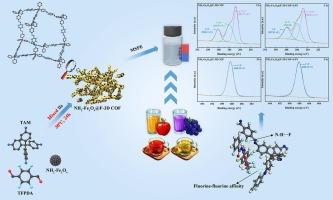Ionic liquids accelerate the crystallization of a magnetic fluorine-functionalized 3D covalent organic framework for efficient capture of trace benzoylurea insecticides in juices and beverages
IF 13.2
1区 工程技术
Q1 ENGINEERING, CHEMICAL
引用次数: 0
Abstract
The fabrication of functionalized three-dimensional covalent organic frameworks (3D COFs) involves intricate and demanding synthetic procedures, which has significantly restricted their broad applications. However, ionic liquids (ILs) have demonstrated the capability to facilitate COF crystallization, shorten reaction durations, and achieve functional modification of COFs. Furthermore, the excessive utilization of benzoylurea insecticides (BUs) in agricultural products is substantially hazardous to ecological systems and human health. Herein, we proposed for the first time a mixed ILs-mediated Schiff base polymerization strategy. It enabled one-step synthesis of a highly crystalline NH₂-Fe₃O₄@F-3D COF at room-temperature conditions, specifically designed for the detection of BUs in complex food matrixes. NH₂-Fe₃O₄@F-3D COF contained a distinctive and well-connected porous structure as well as a high specific surface area (361.4 m2/g). It also contained abundant exposed F groups and a small quantity of -COOH functionalized groups, which were introduced by the 2,3,5,6-tetrafluorobenzaldehyde monomer and ILs. NH₂-Fe₃O₄@F-3D COF exhibited a favorable affinity toward BUs via fluorine‑fluorine affinity and hydrogen bonding interaction. The approach manifested a wide linear scope (25–10,000 ng/L) and possessed low detection thresholds (0.42–2.93 ng/L) regarding the nine analytes being examined. Its effectiveness was further assessed by employing it for detecting BUs in juices and beverages, thus corroborating its adequacy in quantifying trace amounts of BUs in complex food matrixes. The devised high-performance polymerization and functionalization strategy, specifically engineered to fabricate 3D COFs, exhibits extraordinary potential utility in the identification and quantification of contaminants present within practical samples.
F groups and a small quantity of -COOH functionalized groups, which were introduced by the 2,3,5,6-tetrafluorobenzaldehyde monomer and ILs. NH₂-Fe₃O₄@F-3D COF exhibited a favorable affinity toward BUs via fluorine‑fluorine affinity and hydrogen bonding interaction. The approach manifested a wide linear scope (25–10,000 ng/L) and possessed low detection thresholds (0.42–2.93 ng/L) regarding the nine analytes being examined. Its effectiveness was further assessed by employing it for detecting BUs in juices and beverages, thus corroborating its adequacy in quantifying trace amounts of BUs in complex food matrixes. The devised high-performance polymerization and functionalization strategy, specifically engineered to fabricate 3D COFs, exhibits extraordinary potential utility in the identification and quantification of contaminants present within practical samples.

离子液体加速磁性氟功能化3D共价有机框架的结晶,用于有效捕获果汁和饮料中的痕量苯甲酰脲杀虫剂
功能化三维共价有机骨架(3D COFs)的制备过程复杂且要求高,这极大地限制了其广泛应用。然而,离子液体(ILs)已经证明了促进碳纳米管结晶、缩短反应时间和实现碳纳米管功能修饰的能力。此外,苯甲酰脲类杀虫剂在农产品中的过度使用对生态系统和人类健康造成了严重危害。在此,我们首次提出了混合il介导的席夫碱聚合策略。它使在室温条件下一步合成高度结晶的NH₂-Fe₃O₄@F-3D COF成为可能,专门用于检测复杂食品基质中的BUs。NH₂-Fe₃O₄@F-3D COF具有独特且连接良好的多孔结构和高比表面积(361.4 m2/g)。它还含有大量的暴露F基团和少量的-COOH官能团,这些官能团是由2,3,5,6-四氟苯甲醛单体和il引入的。nh2 -Fe₃O₄@F-3D COF通过氟-氟亲合力和氢键相互作用对BUs表现出良好的亲合力。该方法具有宽的线性范围(25-10,000 ng/L),并且对于所检查的9种分析物具有低检测阈值(0.42-2.93 ng/L)。通过将其用于检测果汁和饮料中的BUs,进一步评估了其有效性,从而证实了其在定量复杂食品基质中痕量BUs的充分性。设计的高性能聚合和功能化策略,专门用于制造3D COFs,在实际样品中存在的污染物的识别和量化方面显示出非凡的潜在效用。
本文章由计算机程序翻译,如有差异,请以英文原文为准。
求助全文
约1分钟内获得全文
求助全文
来源期刊

Chemical Engineering Journal
工程技术-工程:化工
CiteScore
21.70
自引率
9.30%
发文量
6781
审稿时长
2.4 months
期刊介绍:
The Chemical Engineering Journal is an international research journal that invites contributions of original and novel fundamental research. It aims to provide an international platform for presenting original fundamental research, interpretative reviews, and discussions on new developments in chemical engineering. The journal welcomes papers that describe novel theory and its practical application, as well as those that demonstrate the transfer of techniques from other disciplines. It also welcomes reports on carefully conducted experimental work that is soundly interpreted. The main focus of the journal is on original and rigorous research results that have broad significance. The Catalysis section within the Chemical Engineering Journal focuses specifically on Experimental and Theoretical studies in the fields of heterogeneous catalysis, molecular catalysis, and biocatalysis. These studies have industrial impact on various sectors such as chemicals, energy, materials, foods, healthcare, and environmental protection.
 求助内容:
求助内容: 应助结果提醒方式:
应助结果提醒方式:


